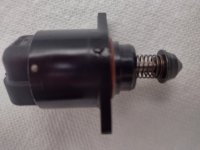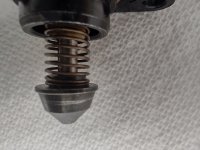I took a look at the IAC valve again and the pictures show it as I just removed it. It is very clean.
I am hesitant to replace the IAC valve as I don't think it is the issue but do not know what is causing the stall condition.
Page 5E-81 of the service manual #17 has an idle air control functional test (2 of 2) states to start the engine, let it warm to operating temperature, record the engine RPM, then put it into base timing mode. A noticeable drop in RPM occurs so the chart then says to exit the base timing mode and the engine speed should return within 75 RPM of the recorded RPM. It does, briefly, then will die. It then states to verify a test light blinks at all four harness terminals (it does). The flow chart then points to a sticky or faulty IAC valve. I have experienced these type of flow charts leading to the wrong conclusion before.
With the scan tool plugged in, it the IAC position value starts off between 12 and 19 when the engine and gradually works its way to 0. Even when the engine stalls, the IAC position is 0 which doesn't seem right but it could be.
It would be nice if there were a method to definitely test the IAC valve so there was no question whether it was good or bad.
I am hesitant to replace the IAC valve as I don't think it is the issue but do not know what is causing the stall condition.
Page 5E-81 of the service manual #17 has an idle air control functional test (2 of 2) states to start the engine, let it warm to operating temperature, record the engine RPM, then put it into base timing mode. A noticeable drop in RPM occurs so the chart then says to exit the base timing mode and the engine speed should return within 75 RPM of the recorded RPM. It does, briefly, then will die. It then states to verify a test light blinks at all four harness terminals (it does). The flow chart then points to a sticky or faulty IAC valve. I have experienced these type of flow charts leading to the wrong conclusion before.
With the scan tool plugged in, it the IAC position value starts off between 12 and 19 when the engine and gradually works its way to 0. Even when the engine stalls, the IAC position is 0 which doesn't seem right but it could be.
It would be nice if there were a method to definitely test the IAC valve so there was no question whether it was good or bad.





















